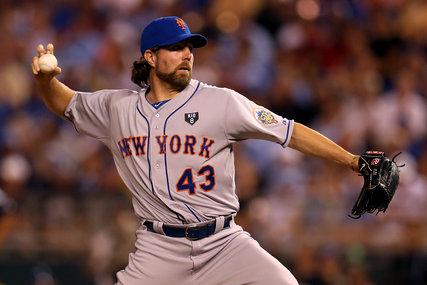I Am What I Throw
The New York Times
July 13, 2012
By Doug Glanville
Every year, my family honors my father with a scholarship given out in his memory to the best students from a church in my hometown, Teaneck, N.J. I always think about what to say to these young student-recipients, and it turns out the best inspiration comes from my dad’s own words. One of my favorite lines of his was “How you do one thing is how you do everything.” And that line now makes me think of the Mets pitcher R.A. Dickey.
I played with Dickey in Texas back in 2003 at a time when he was struggling to hold on to his career. The day he was drafted in 1996, he had the lightning arm expected from a first-round pick. He’d had a stellar career at the University of Tennessee. But the euphoria of being chosen wore off after a physical revealed that he was missing a key elbow ligament a pitcher needs to stabilize his arm. Dickey’s stock plummeted, and he had to take whatever offer he could, signing with Texas for much less than the big money that normally comes with first-round status.
Dickey still made it to the big leagues, hanging on by his fingernails with the Rangers by the time we played together. He was a wonderful teammate, friendly and funny, yet few key evaluators — coaches and opinion drivers — saw a big future for his game. If he did manage to achieve any longevity, they figured he would be the perennial “last guy to know” he’d made the team.
Years after we were teammates, his statistics were going in the wrong direction and he was let go by Texas, only to find himself floundering in Seattle for a season summed up by wild pitches, walks and home runs. Not the best combination for a pitcher. In fact, between 2006 and 2009 he was routinely shown the door. Along the way, in a desperate attempt to reverse his trajectory, Dickey cultivated a pitch he’d used during childhood catches, a pitch few have been able to master well enough to be of any consequence in major league baseball: the knuckleball. After trying out different grips and proving he could get hitters out, he finally found a home in New York nearly 15 years after he was drafted. And he has thrived over the past three seasons.
This year, Dickey has not only thrived, he has dominated. He leads the National League in wins, complete games and shutouts, and is in the top five in many categories (second in strikeouts, fifth in ERA). On Tuesday, he pitched a shutout inning in the All-Star game in Kansas City. His knuckleball is now considered the nastiest pitch in baseball.
As a hitter, I faced my share of knuckleballers — Tim Wakefield, Tom Candiotti, Dennis Springer, to name a few — and I had success against them. But I couldn’t tell you why, exactly. Or not mechanically, anyway.
One theory has it that hitters need to move up in the batter’s box and attack the ball before it makes that final dance into unhittable oblivion. Another theory tells you to “hit the last break,” by swinging after this joystick-controlled UFO makes its (supposedly) final turn in whichever direction. Keep in mind, these are just theories.
A good knuckleball has no spin, at least not the one that acts like the butterfly that just drank enough cocktails to be over the legal drinking limit. And it’s slow enough, and frozen enough, so you can see the letters on the ball. But it’s no comfort reading those letters, since you have absolutely no idea where they’re going, and truth be told, neither does the pitcher. He only has a general sense of the ball’s direction, and one of the only reasons success within this type of guesswork ever comes is because “general” is an adjective that also applies to the strike zone.
The more I learned about Dickey’s life, not just from having been his teammate but from his recent book, “Wherever I Wind Up,”the more prophetic I found my father’s words. Dickey has simplified life by returning to his core, and finding the original blueprint of his success.
Ironically, it was a fastball that he used to rely on — the surest and truest pitch of them all. But he threw it with little plan and little purpose. He was robotic with it: catch, aim, fire and do it again, hoping to have a tomorrow, trying with all his might to be in control, to hide his tumultuous state behind a pitch that surprises no one and that every pitcher has in his repertory.
But Dickey, as a person, has been full of surprises, from his climb up Mount Kilimanjaro to his apology — from the mound, in the heat of competition — when a wayward knuckleball almost took off Alex Rodriguez’s head. There was nothing strait-laced about him, and the boring, linear fastball was not a path to success for him. He had to keep searching for a pitch that was his everything. And with the knuckleball, he has replicated, in a way, his approach to life — throwing something unpredictable.
So I would add this to what my father has said: being at peace with the way you approach one thing can set you free. Once you have confidence in that, you can hit the “copy” button and maybe, someday, rack up an all-star appearance. And never again have to depend on a pitch that may have been your third best one.
Maybe I had success against the knuckleball because I understood R.A. Dickey. (I hope it doesn’t mean that it takes a knuckleball to hit a knuckleballer.) I saw a man who had a future somewhere, who had faith, even when he wasn’t getting anyone out. He always seemed to be thinking, looking for something profound in his life. And, as he has said, he had to get his life in order before he could find order on the field. The knuckleball was the result, and now he is finding out that his name has always been all over it. Floating all the way home.
Republished from The New York Times
Photo Credit: Jonathan Daniel/Getty Images






